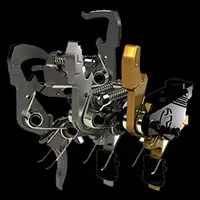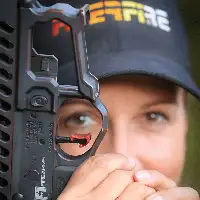The trigger will not burst. But, shooters will burst.
Here are the only two real examples of real people running HIPERTOUCH triggers that burst that HIPERFIRE is aware of:
- A customer installed a trigger in a Colt large pin lower, which increased the pivot pin spacing so much that the semi-auto disconnector could not catch the hammer when it cocked. Sort of like installing a semi-auto trigger into an AR with no disconnector at all. Every time the customer pulled the trigger, the rifle would burst until he let it off completely or the magazine emptied completely. THAT’S WHY HIPERFIRE MENTIONS SMALL, 0.154-INCH DIAMETER, PIVOT PINS SO OFTEN. ‘nough said?
- A customer ran a low mass bolt carrier with a very stiff recoil spring. This resulted in jerky recoil/rebound motion and very fast, high inertia, BCG cycling. Both contributed to simultaneous bump fire and slam fire bursting. The bursts were unpredictable. When a standard weight BCG was installed, the bursts stopped.
Know you’re equipment. All of it. The trigger is just a component of a system that includes the shooter. Just because a shooter experiences this does not mean the problem is the trigger. Maybe it’s the shooter and the ill advised choices he/she has made. If you’re new to high performance rifles of any stripe, don’t operate in a vacuum. Consult those with experience before you attempt something you may not be prepared to handle.
Terry Bender
Terry Bender is HIPERFIRE®'s CEO and runs R&D. He has over 40 years of experience in product and manufacturing process development, private consulting in forensics, failure analysis, and remediation using computational analytic tools. He began designing a firearm about 20 years ago as a personal curiosity. The rest is history.
Yes, reports of trigger “doubling” have come to HIPERFIRE®, but in all cases they were really bump fires. True doubling or bursting occurrences are very rare with any fire control and can indicate faulty installation, wear, debris lodged in the trigger due to poor maintenance, manufacture, etc.
If the trigger’s design or manufacture is flawed, once it “doubles” it will always double. If the doubling is inconsistent, the issue may not be with the fire control at all, but rather the way that the shooter is using the fire control. Ensuring that the user is pulling the trigger all the way through break to complete over travel, maintaining a firm hold on the pistol grip during the rifle’s recoil onto and rebound off of the shoulder, increasing the pull weight of the trigger, etc. are all effective ways to maximize shooter control thereby minimizing or eliminating bump fires.
Terry Bender
Terry Bender is HIPERFIRE®'s CEO and runs R&D. He has over 40 years of experience in product and manufacturing process development, private consulting in forensics, failure analysis, and remediation using computational analytic tools. He began designing a firearm about 20 years ago as a personal curiosity. The rest is history.
After-market anti-walk and anti-rotation pins can produce variations in pull weight from what HIPERFIRE® specifies, a grittier feel, and/or alter the FCG’s overall performance, like reducing hammer fall energy, providing an inferior user experience.
HIPERFIRE® recommends that users first install the MIL-spec pins that come with the packaged HIPERTOUCH® product to baseline their experience for comparison’s sake and then make the decision as to whether other pins might be preferred for reasons like aesthetics, etc.
Terry Bender
Terry Bender is HIPERFIRE®'s CEO and runs R&D. He has over 40 years of experience in product and manufacturing process development, private consulting in forensics, failure analysis, and remediation using computational analytic tools. He began designing a firearm about 20 years ago as a personal curiosity. The rest is history.
We recommend the MIL_spec pins included with the product. Users have contacted HIPERFIRE® regarding hammer fall and pull weight issues with the use of various anti-rotation pin products. In some cases:
- These pins are larger that the MIL-spec .154-inch pins causing a slight binding of the hammer on the pin;
- The pins are worn out of shape or damaged;
- The pins have no hammer J-spring groove so that the hammer fall is slowed due to pinching friction; and or
- The anti-rotation pins clamping action on the lower can actually squeeze the lower receiver’s walls together clamping in turn the hammer and/or trigger.
In these cases, HIPERFIRE® recommends taking out the anti-rotation (anti-walk) pins and install the pins supplied with the HIPERTOUCH® trigger to baseline optimal performance. After knowing how the FCG should work as designed and most importantly how it should feel, the user can then try other pins for comparison. If the others work out okay, go ahead and use them. If not, abandon them and go back to the pins supplied in the HIPERTOUCH® package.
Terry Bender
Terry Bender is HIPERFIRE®'s CEO and runs R&D. He has over 40 years of experience in product and manufacturing process development, private consulting in forensics, failure analysis, and remediation using computational analytic tools. He began designing a firearm about 20 years ago as a personal curiosity. The rest is history.
No, the FCG’s (Fire Control Group) trigger weights cannot be adjusted to 4½ pounds and greater on these models. FCG trigger weights are more or less the same between all three models and range as follows based on toggle spring pair used:
- Plain or Gray: 2 ½ – 2 ¾ pounds
- Yellow: 3 ½ – 3 ¾ pounds
- Blue: 4 – 4 ¼ pounds
Terry Bender
Terry Bender is HIPERFIRE®'s CEO and runs R&D. He has over 40 years of experience in product and manufacturing process development, private consulting in forensics, failure analysis, and remediation using computational analytic tools. He began designing a firearm about 20 years ago as a personal curiosity. The rest is history.
No, they are not the same. Here’s the main difference between the 24C & 24E, other than trigger shape.
The 24E’s initial creep is very short, some say a “hint of creep,” with subsequent shots exhibiting a little less creep if trigger let-off is stopped at hammer reset and the follow-up shot is made from there.
However, on the 24C, the initial creep is virtually zero, i.e. it creeps, but most shooters can’t feel it. And, regardless of finger control during reset, subsequent shots are identical in feel to the first shot, resulting in optimal feel consistency and trigger transparency. Trigger transparency means that the shooter now can simply think “shoot” and the rifle fires instead of being over conscious about the feel and mechanics of pulling the trigger, which is a distraction to shooting resulting in poor timing and poor accuracy. The reason no one likes MIL-spec triggers is that you can’t keep from thinking how terrible it feels. That’s not transparency.
Terry Bender
Terry Bender is HIPERFIRE®'s CEO and runs R&D. He has over 40 years of experience in product and manufacturing process development, private consulting in forensics, failure analysis, and remediation using computational analytic tools. He began designing a firearm about 20 years ago as a personal curiosity. The rest is history.









